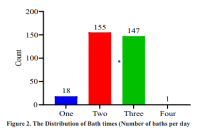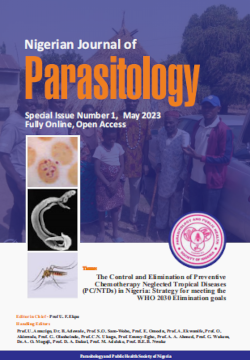Prevalence and Epidemiology of Scabies Among School Children in Calabar, Cross River State, Nigeria.
DOI:
https://doi.org/10.4314/njpar.v46i2.15Keywords:
Awareness, Risk factors, School-age children, ScabiesAbstract
Scabies, a common parasitic skin disease in the tropics and other low-income settings, induces incessant scratching provoked by intense pruritus, with diminished school performance and quality of life in affected individuals. This study explored the epidemiology and risk factors of scabies and the relevant associations among school-age children in Calabar, Southeastern Nigeria. This cross-sectional study was conducted among 321 school-age children in Calabar, Cross River State, Nigeria. Simple random sampling by balloting was used to select the schools, while systematic random sampling was used to recruit study participants. An interviewer-administered questionnaire was used to collect data on sociodemographic characteristics as well as information on personal and
environmental hygiene. Scabies prevalence was calculated using binomial probability confidence intervals for proportions, and the risk factors were analysed using bivariate and multivariate regression analyses. The prevalence of scabies was 21% (95% CI: 16%–25%). In bivariate analysis, risk factors for scabies prevalence included male sex, household cat ownership, and bed-sharing among siblings. There was a significant association between maternal education and scabies prevalence. These findings highlight the pressing need for evidencebased targeted public health interventions by regional and national authorities, as well as relevant stakeholders within the country.
References
Chosidow O. (2006). Clinical practices. Scabies. The New England Journal of Medicine, 354(16), 1718–1727. https://doi.org/10.1056/NEJMcp052784
World Health Organization. (2023). Scabies Fact Sheet. https://www.who.int/news-room/factsheets/detail/scabies (accessed July 24, 2023).
Hengue, U. R., Currie, B. J., Jager, G., Lupi, O., & Schwartz, R. A. (2006). Scabies: a ubiquitous neglected skin disease. The Lancet Infectious Diseases, 6(12), 769–779. https://doi.org/10.1016/S1473-3099(06)70654-5
Chosidow, O., & Fuller, L. C. (2017). Scratching the itch: is scabies a truly neglected disease? The Lancet Infectious Diseases, 17, 1220–1. https://doi.org/10.1016/S1473-3099(17)30469-3
Karimkhani, C., Colombara, D. V., Drucker, A. M., Norton, S. A., Hay, R., Engelman, D., Steer, A., Whitfeld, M., Naghavi, M., & Dellavalle, R. P. (2015). The global burden of scabies: A cross-sectional analysis from the Global Burden of Disease Study. The Lancet Infectious Diseases, 17, 1247–54. https://doi.org/10.1016/S1473-3099(17)30483-8
Amare, H. H., & Lindtjorn B. (2021). Risk factors for scabies, tungiasis, and tinea infections among schoolchildren in southern Ethiopia: A cross-sectional Bayesian multilevel model. PLoS Neglected Tropical Diseases, 15, e0009816. https://doi.org/10.1371/journal.pntd.0009816
Hay, R. J., Steer, A. C., Engelman, D., & Walton S. (2012). Scabies in the developing world--its prevalence, complications, and management. Clinical Microbiology and Infection, 18, 313–23. https://doi.org/10.1111/j.1469-0691.2012.03798.x
Collège des universitaires de Maladies Infectieuses et Tropicales. (2016). ePILLYtrop 2016 - Maladies infectieuses tropicales, 25th edn. Paris: online, 2016 http://www.infectiologie.com/. (accessed July 24, 2023).
Roberts, L. J., Huffam, S. E., Walton, S. F., & Currie B. J. (2005). Crusted scabies: clinical and immunological findings in seventy-eight patients and a review of the literature. Journal of Infection, 50, 375–81. https://doi.org/10.1016/j.jinf.2004.08.033
Arlian, L. G., & Morgan M. S. (2017). Areview of Sarcoptes scabiei: past, present and future. Parasites & Vectors, 10, 297. https://doi.org/10.1186/s13071-017-2234-1
Swe, P. M., Christian, L. D., Lu, H. C., Sriprakash, K. S., & Fischer, K. (2017). Complement inhibition by Sarcoptes scabiei protects Streptococcus pyogenes - An in vitro study to unravel the molecular mechanisms behind the poorly understood predilection of S. pyogenes to infect mite-induced skin lesions. PLOS Neglected Tropical Diseases, 11,e0005437. https://doi.org/10.1371/journal.pntd.0005437
Welch, E., Romani, L., & Whitfeld, M. J. (2021). Recent advances in understanding and treating scabies. Faculty Reviews, 10,28. https://doi.org/10.12703/r/10-28
World Health Organization. (2005). Epidemiology and management of common skin diseases in children in developing countries. World Health Organization, 2005. https://apps.who.int/iris/handle/10665/69229 (accessed Nov 10, 2021).
Engelman, D., Kiang, K., Chosidow, O., McCarthy, J., Fuller, C., Lammie, P., Hay, R., & Steer, A. (2013). Toward the global control of human scabies: introducing the International Alliance for the Control of Scabies. PLoS Neglected Tropical Diseases, 7, e2167–e2167. https://doi.org/10.1371/journal.pntd.0002167
Feldmeier, H., & Heukelbach, J.(2009). Epidermal parasitic skin diseases: a neglected category of poverty-associated plagues. Bulletin of the World Health Organization, 87,152–9. https://doi.org/10.2471/blt.07.047308
Sanei-Dehkordi, A., Soleimani-Ahmadi, M., Zare, M., & Jaberhashemi, S. A. (2021). Risk factors associated with scabies infestation among primary schoolchildren in a low socio-economic area in southeast of Iran. BMC Paediatrics, 21, 249. https://doi.org/10.1186/s12887-021-02721-0
Ugbomoiko, U. S., Oyedeji, S. A., Babamale, O. A., & Heukelbach, J. (2018). Scabies in resource-poor communities in Nasarawa state, Nigeria: Epidemiology, clinical features and factors associated with infestation. Tropical Medicine and Infectious Disease, 3, 59. https://doi.org/10.3390/tropicalmed3020059
Seetan, K., Rashdan, Y., Alsharei, A., Al Bashir, S., Al Madani, A., Alqa'dan, M., Al Momani, A., & Al Samarah, H. (2021). Impact of socio-demographic factors on knowledge, attitude and practices toward scabies among Syrian refugees in Jordan: Aprospective cross sectional study. Annals of Medicine and Surgery, 69, 2021. https://doi.org/10.1016/j.amsu.2021.102738.
World Health Organization. (2017). Integrating neglected tropical diseases into global health and development: Fourth WHO report on neglected tropical diseases – Executive summary. World Health Organization. https://apps.who.int/iris/handle/10665/255013 (accessed Nov 10, 2023).
Engelman, D., Cantey, P. T., Marks, M., Chen, S., Sabbagh, R., & Hay, R. J. (2019). The public health control of scabies: Priorities for research and action. The Lancet, 394(10192), 81–92. https://doi.org/10.1016/S0140-6736(19)31136-5
World Health Organization. (2020). Neglected tropical diseases of the skin: WHO launches mobile application to facilitate diagnosis. https://www.who.int/news/item/16-07-2020-neglected-tropical-diseases-of-the-skinwholaunches-mobile-application-to-facilitate-diagnosis (accessed July 24, 2023).
Lawshe, C. H. (1975). A Quantitative Approach to Content Validity1. Personnel Psychology, 28, 563–75. http://dx.doi.org/10.1111/j.1744-6570.1975.tb01393.x
Taherdoost, H. (2016). Validity and Reliability of the Research Instrument; How to Test the Validation of a Questionnaire/Survey in a Research. Rochester, NY. Social Science Research Network, https://doi.org/10.2139/ssrn.3205040.
Kish, L.(1965). Survey Sampling. New York: John Wiley and Sons, Inc.
Glenn, D. I.(1992). Determining Sample Size. Published online Nov. 1992 https://www.tarleton.edu/academicassessment/documents/samplesize.pdf. (accessed July 24, 2023).
Henshaw, E. B., & Olasode, O. A. (2015). Skin diseases in Nigeria: the Calabar experience. International Journal of Dermatology, 54, 319–326. https://doi.org/10.1111/ijd.12752
Park, H., & Leemis, L. M. (2019). Ensemble confidence intervals for binomial proportions. Statistics in Medicine, 38,3460–3475. https://doi.org/10.1002/sim.8189
Sundar, D. R. (2014). Binomial confidence intervals for several parameterizations (Version 1.1-1) [R package]. https://CRAN.R-project.org/package=binom
Dunnigan, K.(2008). Confidence interval calculation for binomial proportions. Semantic Scholar. https://www.semanticscholar.org/paper/Confidence-Interval-Calculation-for-BinomialDunnigan/75b609976d74b33a66a7653d9941c4f1bda5c13chttps://www.semanticscholar.org/paper/ConfidenceInterval-Calculation-for BinomialDunnigan/75b609976d74b33a66a7653d9941c4f1bda5c13c (accessed Nov 10, 2023).
Dunnigan, K.(2008). Confidence interval calculation for binomial proportions. https://www.semanticscholar.org/paper/Confidence-Interval-Calculation-for-BinomialDunnigan/75b609976d74b33a66a7653d9941c4f1bda5c13 (accessed July 24, 2023).
Ogunbiyi, A.O., Owoaje, E., & Ndahi, A. (2005). Prevalence of skin disorders in school children in Ibadan, Nigeria. Pediatric Dermatology, 22(1), 6–10. https://doi.org/10.1111/j.1525-1470.2005.22102.x
Beeres, D. T., Ravensbergen, S. J., Heidema, A., van den Bogaard, M., Vlot, J. A., Sonder, G. J. B., & van den Hoek, A. (2018). Efficacy of ivermectin mass-drug administration to control scabies in asylum seekers in the Netherlands: A retrospective cohort study between January 2014 – March 2016. PLOS Neglected Tropical Diseases, 12(5), e0006401. https://doi.org/10.1371/journal.pntd.0006401
Chosidow, O., & Hay, R. J. (2019). Control of scabies and secondary impetigo: Optimising treatment effectiveness in endemic settings. The Lancet Infectious Diseases, 19(5), 454–456. https://doi.org/10.1016/S1473-3099(18)30780-5
Romani, L., Marks, M., Sokana, O., Nasi, T., Kamoriki, B., Bong, A., Koroi, A., Gilmore, S. J., Maki, E., Koroivueta, J., Venturini, E., Cama, A., Steer, A. C., & Solomon, A. W. (2019). Efficacy of mass drug administration with ivermectin for control of scabies and impetigo, with coadministration of azithromycin: A single-arm community intervention trial. The Lancet Infectious Diseases, 19(5), 510–518. https://doi.org/10.1016/S1473-3099(18)30790-4
Rinaldi, G., & Porter, K. (2021). Mass drug administration for endemic scabies: A systematic review. Tropical Diseases, Travel Medicine and Vaccines, 7, 21. https://doi.org/10.1186/s40794-021-00152-6
Feldmeier, H., Jackson, A., Ariza, L., Calheiros, C. M. L., Soares, V. L. P., Oliveira, F. A., & Heukelbach, J. (2009). The epidemiology of scabies in an impoverished community in rural Brazil: Presence and severity of disease are associated with poor living conditions and illiteracy. Journal of the American Academy of Dermatology, 60(3), 436–443. https://doi.org/10.1016/j.jaad.2008.09.035
Tiwari, J. & Kabirpanthi, V. (2015). Prevalence of scabies and associated risk factors among patients attending general OPD of a community health centre in Panna District: Ahospital based study. Medical Science, 4:312-4.
Haile, T., Sisay, T., & Jemere, T. (2020). Scabies and its associated factors among under 15 years children in Wadila district, Northern Ethiopia, 2019. The Pan African Medical Journal, 37,224. https://doi.org/10.11604/pamj.2020.37.224.23932
Arlian, L. G., Runyan, R. A., & Estes, S. A. (1984). Cross infestivity of Sarcoptes scabiei. Journal of the American Academy of Dermatology, 10(6), 979–986. https://doi.org/10.1016/S0190-9622(84)80388-3
Malik, R., Stewart, K. M., Sousa, C. A., Foster, S. F., Martin, P., & McDonagh, P.(2016). Crusted scabies (Sarcoptic mange) in four cats due to Sarcoptes scabiei infestation. Journal of Feline Medicine and Surgery. Advance online publication. https://doi.org/10.1016/j.jfms.2006.05.005
Heukelbach, J., Kuenzer, M., Counahan, M., Feldmeier, H., & Speare, R. (2006). Correct diagnosis of current head lice infestation made by affected individuals from a hyperendemic area. International Journal of Dermatology, 45(12), 1437–1438. https://doi.org/10.1111/j.1365-4632.2006.02970.x

Downloads
Published
How to Cite
Issue
Section
License
Copyright (c) 2025 Nigerian Journal of Parasitology

This work is licensed under a Creative Commons Attribution-NonCommercial-NoDerivatives 4.0 International License.




